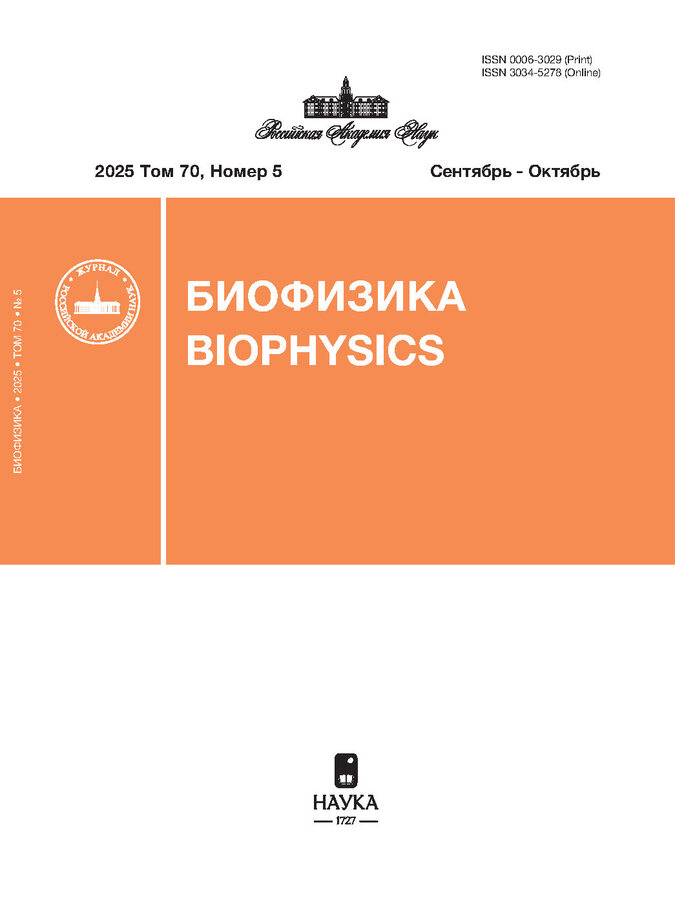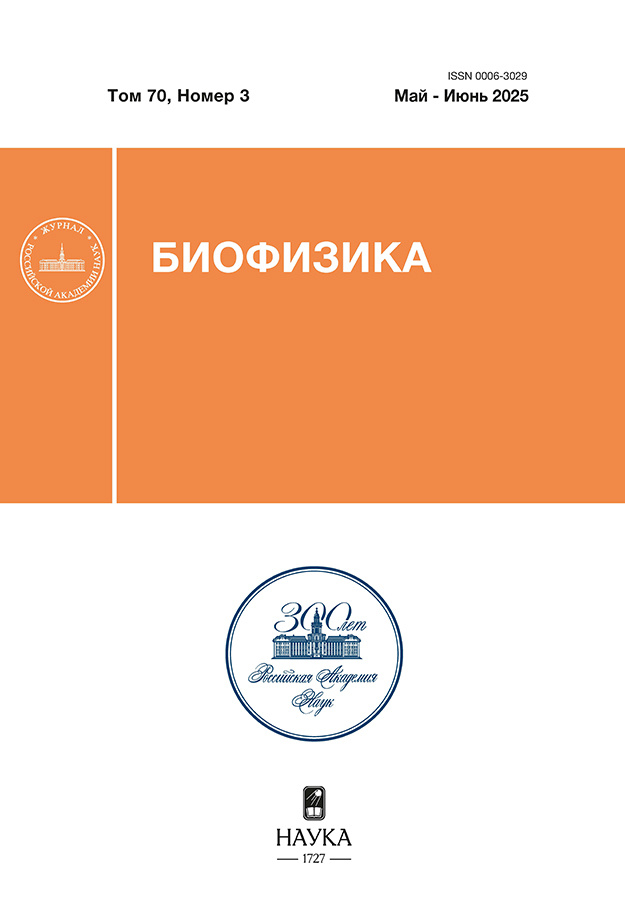Analysis of Competitive Ligand Binding to DNA: Using Dyes as Fluorescent Sensors
- Authors: Nechipurenko Y.D1,2, Novikova E.A1, Smirnov N.M1, Khorunzheva K.K3, Paponov B.V4, Arutyunyan A.F1, Kaluzhny D.N1
-
Affiliations:
- Engelhardt Institute of Molecular Biology, Russian Academy of Sciences
- Research Institute for Brain Development and Peak Performance, RUDN University
- Moscow Institute of Physics and Technology (National Research University)
- Pavlov First Saint Petersburg State Medical University
- Issue: Vol 70, No 3 (2025)
- Pages: 430-438
- Section: Molecular biophysics
- URL: https://rjraap.com/0006-3029/article/view/687534
- DOI: https://doi.org/10.31857/S0006302925030026
- EDN: https://elibrary.ru/KSFNYU
- ID: 687534
Cite item
Abstract
About the authors
Y. D Nechipurenko
Engelhardt Institute of Molecular Biology, Russian Academy of Sciences; Research Institute for Brain Development and Peak Performance, RUDN University
Email: nech99@mail.ru
Moscow, Russia; Moscow, Russia
E. A Novikova
Engelhardt Institute of Molecular Biology, Russian Academy of SciencesMoscow, Russia
N. M Smirnov
Engelhardt Institute of Molecular Biology, Russian Academy of SciencesMoscow, Russia
K. K Khorunzheva
Moscow Institute of Physics and Technology (National Research University)Dolgoprudny, Russia
B. V Paponov
Pavlov First Saint Petersburg State Medical UniversitySaint Petersburg, Russia
A. F Arutyunyan
Engelhardt Institute of Molecular Biology, Russian Academy of SciencesMoscow, Russia
D. N Kaluzhny
Engelhardt Institute of Molecular Biology, Russian Academy of Sciences
Email: uzhny@mail.ru
Moscow, Russia
References
- Healy E. F. Quantitative determination of DNA–ligand binding using fluorescence spectroscopy. J. Chem. Education, 84 (8), 1304 (2007). doi: 10.1021/cd084p1304
- Zasedatelev A. S., Gursky G. V., Zimmer C. H., and Thrum H. Binding of netropin to DNA and synthetic polynucleotides. Mol. Biol. Reports, 1 (6), 337–342 (1974). doi: 10.1007/BF00309567
- del Villar-Guerra R., Gray R. D., Trent J. O., and Chaires J. B. A rapid fluorescent indicator displacement assay and principal component/cluster data analysis for determination of ligand–nucleic acid structural selectivity. Nucl. Acids Res., 46 (7), e41–e41 (2018). doi: 10.1093/nar/gkv019
- Tse W. C. and Boger D. L. A fluorescent intercalator displacement assay for establishing DNA binding selectivity and affinity. Accounts Chem. Res., 37 (1), 61–69 (2004). doi: 10.1021/an030113y
- Domotor O., Binacchi F., Ribeiro N., Busto N., Gonzalez-Garcia J., Garcia-España E., Correia I., Enyedy E. A., Hamacek J., Terenzi A., Basilio N., Barone G., Cavaco I., and Biver T. How reliable is the evaluation of DNA binding constants? Insights and best practices based on an inter-laboratory fluorescence titration study. Spectrochim. Acta Part A: Mol. Biomol. Spectrosc., 327, 125354 (2025). doi: 10.1016/j.saa.2024.125354
- Lepecq J. B. and Paoletti C. A fluorescent complex between ethidium bromide and nucleic acids: Physical–chemical characterization. J. Mol. Biol., 27 (1), 87–106 (1967). doi: 10.1016/0022-2836(67)90353-1
- Bazhulina N. P., Nikitin A. M., Rodin S. A., Surowaya A. N., Kravatsky Y. V., Pismensky V. F., Archipova V. S., Martin R., and Gursky G. V. Binding of Hoechst 33258 and its derivatives to DNA. J. Biomol. Struct. Dyn., 26 (6), 701–718 (2009). doi: 10.1080/07391102.2009.10507283
- Haq I., Ladbury J. E., Chowdhry B. Z., Jenkins T. C., and Chaires J. B. Specific binding of hoechst 33258 to the d(CGCAAATTTCGCG)2 duplex: calorimetric and spectroscopic studies. J. Mol. Biol., 271 (2), 244–257 (1997). doi: 10.1006/jmbl.1997.1170
- Bradley D. and Lifson S. Statistical mechanical analysis of binding of acridines to DNA. In: Molecular associations in biology (Proc. Int. Symp. Held in Celebration of the 40th Anniversary of the Institute de Biology Physico-Chimique). Ed. by B. Pullman (Acad. Press, 2012), pp. 261–270. doi: 10.1016/B978-0-12-395638-5.50021-5
- Latt S. A. and Sober H. A. Protein-nucleic acid interactions. II. Oligopeptide–polythonucleotide binding studies. Biochemistry, 6 (10), 3293–306 (1967). doi: 10.1021/bt00862a040
- Crothers D. M. Calculation of binding isotherms for heterogeneous polymers. Biopolymers, 6 (4), 575–584 (1968). doi: 10.1002/bip.1968.360060411
- Заседателев А. С., Гурский Г. В. и Волькенштейн М. В. Теория одномерной адсорбции. I. Адсорбция малых молекул на гомополимере. Молекуляр. биология, 5 (2), 245–490 (1971).
- Нечипуренко Ю. Д. и Бучельников А. С. Связывание лигандов с нуклеиновыми кислотами в растворе и на микрочитах. Биофизика, 67 (3), 456–466 (2022). doi: 10.31857/S000630292203005X, EDN: ANDOHM
- McGhee J. D. and von Hippel P. H. Theoretical aspects of DNA-protein interactions: Co-operative and non-co-operative binding of large ligands to a one-dimensional homogeneous lattice. J. Mol. Biol., 86 (2), 469–489 (1974). doi: 10.1016/0022-2836(74)90031-x
- Нечипуренко Ю. Д. Кооперативные взаимодействия при связывании протяженных лигандов с ДНК. II. Контактные кооперативные взаимодействия между адсорбированными лиганами. Молекуляр. биология, 18, 1066–1079 (1984).
- Nechipurenko Y. D. and Gursky G. V. Cooperative effects on binding of proteins to DNA. Biophys. Chem., 24 (3), 195–209 (1986).
- Нечипуренко Ю. Д. Анализ связывания биологически активных соединений с нуклеиновыми кислотами (ИКИ, Ижевск, 2015).
- Torralba A. S., Colmenarejo G., and Montero F. Sequence distribution and intercooperativity detection for two ligands simultaneously binding to DNA. Biopolymers, 58 (6), 562–576. doi: 10.1002/1097-0282(200105)586<562::AID-BIP1031>30.CO;2-8
- Nechipurenko Y. D., Mikheikin A. L., Streltsov S. A., Zasedatelev A. S., and Nabiev I. R. Mixed Mode of Ligand-DNA Binding Results in S-Shaped Binding Curves. J. Biomol. Struct. Dyn., 18 (5), 703–708 (2001). doi: 10.1080/07391102.2001.10506700
- Круглова, Е. Б. и Зиненко Т. Л. Экспериментальные и теоретические исследования образования комплексов ДНК с биологически активными лигандами, содержащими хромофорные группы, в зависимости от ионной силы раствора. Молекуляр. биология, 27 (3), 655–665 (1993).
- Schwarz G. and Stankowski S. Linear cooperative binding of large ligands involving mutual exclusion of different binding modes. Biophys Chem., 10 (2), 173–181 (1979). doi: 10.1016/0301-4622(79)85037-1
- Шульга С. И. и Чуйгук В. А. Полиметиновые красители из глазоло[3,2-а]пиримиллиненных пиримидо[2,1],–b]бентдиазолиевых солей. Укр. хим. журн., 39 (11), 1151–1155 (1973).
- Zhao Z. and Hartmann H. Synthesis of reactive condensation products of acetylacetone and their transformation into deeply coloured methine dyes. J. Prakt. Chem., 342 (3), 249–255 (2000). doi: 10.1002/(sici)1521-3897(200003)342:3<249::aid-prac249>3.0.co;2-8
- Monchaud D. and Teulade-Fichou M.-P. G4-FID: A fluorescent DNA probe displacement assay for rapid evaluation of quadruplex ligands. Methods Mol. Biol., 608, 257–271 (2010). doi: 10.1007/978-1-59745-363-9_15
Supplementary files











